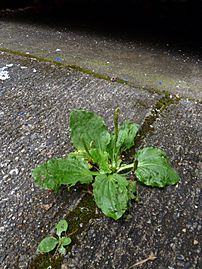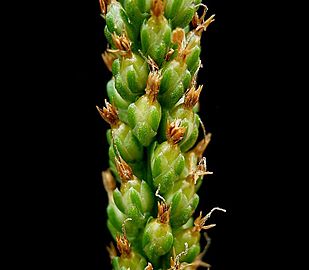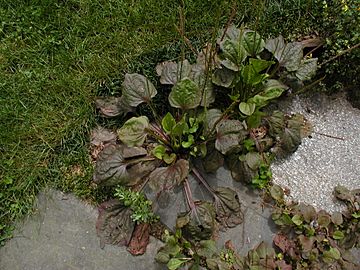Broadleaf plantain facts for kids
Quick facts for kids Broadleaf plantain |
|
|---|---|
 |
|
| Conservation status | |
| Scientific classification | |
| Genus: |
Plantago
|
| Species: |
major
|
Plantago major, often called broadleaf plantain, is a common flowering plant. You might also hear it called "white man's footprint" or "waybread." It belongs to the plantain family, Plantaginaceae. This plant originally comes from Europe and Asia.
You can eat the young, soft leaves raw. Older, tougher leaves can be cooked in stews.
Contents
What Broadleaf Plantain Looks Like
Broadleaf plantain is a herbaceous plant, meaning it has soft stems, not woody ones. It's also a perennial, so it lives for more than two years. It grows a group of leaves in a circle, called a rosette, about 15 to 30 centimeters (6 to 12 inches) wide.
Each leaf is oval-shaped. They are usually 5 to 20 cm (2 to 8 in) long and 4 to 9 cm (1.5 to 3.5 in) wide. The leaves have a smooth edge and a clear stem, called a petiole, which is almost as long as the leaf itself. You can see five to nine strong veins running along the leaf.
The plant's flowers are tiny and greenish-brown. They have purple parts called stamens. These flowers grow in a thick spike that is 5 to 15 cm (2 to 6 in) long. This spike sits on top of a stem that is usually 13 to 15 cm (5 to 6 in) tall, but it can sometimes reach 70 cm (28 in).
Plantain flowers are pollinated by the wind. They mostly spread by seeds. These seeds grow on the long, thin spikes that stand above the leaves. Each plant can make up to 20,000 tiny, oval-shaped seeds. They have a bitter taste.
Plantain's Family Tree
It's important to know that broadleaf plantain is not related to the fruit called "plantain." The fruit plantain is a type of banana. They just happen to share a similar name!
Where Broadleaf Plantain Grows
This plant is native to most of Europe and parts of northern and central Asia. However, it has spread and now grows naturally in many other parts of the world.
Plantago major often grows in places where humans have been active. You can find it in lawns, fields, and along roadsides. It grows especially well in compacted or disturbed soils. Many people believe it was one of the first plants to arrive in North America with European settlers. Some Native American groups even called it "white man's footprint." This was because it grew well in the disturbed areas around European settlements.
Plantain's ability to survive being walked on often and to grow in hard soils makes it helpful for soil rehabilitation. Its roots can break up hard ground. At the same time, they help hold the soil together, which stops erosion. Plantain seeds are often found mixed in with cereal grains and other crop seeds. This is another reason why it has spread all over the world.
How People Use Plantain
The mature plant has strong, flexible fibers. In survival situations, these fibers can be used to make small cords, fishing line, or even sutures for wounds.
Some types of broadleaf plantain are grown as ornamental plants in gardens. For example, 'Rubrifolia' has purple leaves, and 'Variegata' has leaves with different colors.
Eating Plantain
The young leaves of broadleaf plantain are edible. You can eat them as a salad green. However, as the leaves get older, they become tough and stringy. These older leaves can be cooked in stews. Plantain leaves contain calcium and other minerals. About 100 grams (3.5 ounces) of plantain has about the same amount of beta-carotene as a large carrot. The seeds are very small, so they are hard to collect. But they can be ground into a flour to use for baking.
Plantain in Traditional Medicine
Plantain contains natural chemicals like allantoin and flavonoids. These chemicals have been studied for their possible health benefits.
In folk medicine, plantain leaves were often used on the skin. They were made into poultices, which are soft, moist masses applied to wounds, sores, or insect stings. The root of the plant was sometimes used for fevers and breathing problems.
Gallery
See also
 In Spanish: Llantén mayor para niños
In Spanish: Llantén mayor para niños





